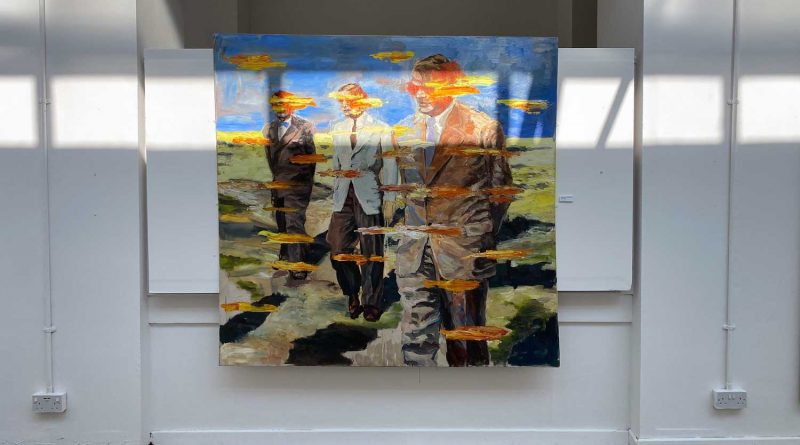Art and architecture: Terence Williams Retrospective at Stour Gallery, Old Baths
Arts correspondent Rosie Wadey reviews the Terence Williams Retrospective at Stour Gallery in the Old Baths building. The art show may be temporary, but Wadey says the grand art deco building with plenty of indoor sunlight is an ideal space to catch any art show.
When approaching 80 Eastway, you would be forgiven for mistaking the graphic 1930s Art Deco façade for a municipal building. Upon closer inspection of the brass plaque on the front, you will learn that in its former life, the listed building was indeed operated by the council, housing the Gainsborough Road Public Baths.
Renovated in the 1990s and now home to photography studios, a community garden, cafe, gallery and event spaces, the structure has been given a new lease of life. The baths may be long gone but the site still serves the local community 86 years later via an innovative 2018 scheme to re-appoint disused council buildings as arts hubs.
On a sunny day in mid-September, I paid a visit to Stour Gallery, who have made their home here. The gallery is the sister to arts organisation Stour Space (who are Hackney Wick veterans) and aims to showcase contemporary practitioners in a wide range of mediums. I was there to see the works of painter Terence Williams, whose retrospective has been on show there for the last month.
Williams’ work is for fans of 20th century figurative painting. For this exhibition, his oil paintings were split into three distinct collections: Beach, Click, and Political. Straight ahead as you enter from the hallway, the lounge space offered up works from the first of these categories, Beach.
The large scale paintings in this series are characterised by the use and appropriation of images available in the public domain. Williams paints, collages and manipulates existing imagery to create new works that grapple with mundane everyday and ‘evoke alternative narratives’.
The Beach series was motivated by a desire to examine how ‘behaviour is magnified and becomes more explicit at the seaside… in particular the act of disrobing, which is often accompanied by the colonisation of space.’
In The Early Birds, two elderly ladies sit side by side slouching in front of a pool with dishevelled clothing and relaxed poses. They seem to represent a quintessentially British seaside goer, normally portrayed in wryly humorous documentary photographs. In Blue Apple, a rather portly man reaches for his smartphone in yellow swim-shorts, with yellow hands painted in to match. Williams has sketched out the outline of an umbrella above, but it provides no cover. The reds in his palette give his skin a radiating sunburn.
Exiting the lounge, we moved to a large daylight gallery space down the hall, where five of Williams’ Political works are displayed. The paintings here are large scale and uncompromising. His subject matter moves easily from the idiosyncrasies of people at the beach to figurative works capturing fictional scenes from the interwar period up to the Cold War era.
There is more than a hint of Soviet iconography here with splashes of red in ‘Red Hot Microphone’ obscuring the identity of a man perhaps about to speak. Suited figures hover over his shoulder, and they appear to jostle for power, whilst in the background a hand displays a crumpled sign (a placard, a newspaper?). The political paintings in this room don’t depict real events, but they may as well have been composed from periods of historical tension.
My favourite of the works here (and in the whole exhibition) was Too Much Recollection. Capturing three men in casual suits, Williams eerily blots out their eyes with carefully positioned, fiery orange brushstrokes, streaking in motion across the canvas. The men seem familiar to each other, but distant; perhaps ruminating on some authoritarian strategy. The three other works in this room deal with themes of duty and loyalty, a newly wed couple walk alongside militaristic figures.
In conclusion, a visit to Old Baths will appeal to those with an interest in local history and an interest in art, or if you are simply looking to explore hidden new corners of your area. The building itself is also interesting in its own right, retaining much of its original detail with exposed brickwork and supporting pillars. Plus, its huge vaulted skylight ceiling offers plenty of daylight for detailed art gallery viewings.
As for the current exhibition in Stour Gallery inside the Old Baths, Terence Williams’ Retrospective is a short, yet pleasurable insight into the work of a talented artist, and I look forward to seeing more from him and Stour Gallery.
Interested in art? You might like to read Rosie Wadey’s other piece, ‘Culture in the time of Covid: Radical Figures at Whitechapel Gallery.‘


